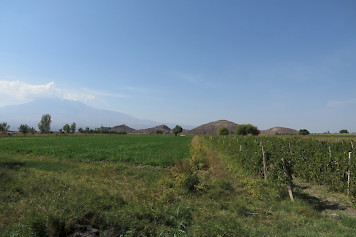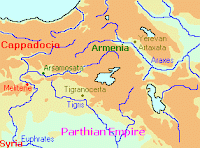Tigranes VI
Tigranes VI "the Cappadocian": pro-Roman king of Armenia (r. 59-62 CE).
Crisis

In 52, the Parthian king Vologases invaded Armenia, occupied its capitals Artaxata and Tigranocerta, and made his younger brother Tiridates king of Armenia.note This was a breach of an old treaty, which the Parthian king Phraates IV had concluded with the Roman emperor Augustus in 20 BCE: the Romans would appoint the Armenian king. In response to this violation of the treaty, the Roman emperor Nero sent out general Corbulo to the east.
Corbulo first reorganized the army in Galatia and Cappadocia,note which included instructions to his vassal kings. Herod Agrippa II of Judaea and Antiochus IV of Commagene prepared bridges across the Euphrates. Two new vassal kingdoms were created: Sophene (on the Euphrates) was assigned to the Syrian prince Sohaemus and Lesser Armenia (on the Black Sea) to Aristobulus,note who was, like Herod Agrippa, a descendant of king Herod the Great. Polemon II of Pontus, brother of an earlier king of Armenia, appears to have been another Roman ally.note

A diplomatic solution proved elusive when Tiridates started to threaten pro-Roman Armenians. So the war broke out in 58 CE.note After some initial fighting between the Armenians and the Roman forces, Corbulo advance to Artaxata, forcing Tiridates to defend it, and risk a pitched battle. Indeed, the city fell,note followed by the other capital, Tigranocerta, in the next year, 59 CE.note Tiridates fled and when he tried to return, he found that the Romans had blocked the roads.note
A New King
The Romans, now in control of Armenia, installed a new, pro-Roman king, Tigranes VI, supported by a Roman garrison.note This may in fact have been a gesture to Herod Agrippa. Several parts of Armenia were added to the realms of the allies: Aristobulus expanded Lesser Armenia, Polemo expanded Pontus, and Antiochus expanded Commagene. Herod Agrippa's territories were too far to the south, so he may have been rewarded with another royal title in the Herodian family. According to Flavius Josephus, he was a son of a man named Alexander, who was a grandson of Herod the Great;note his mother was a granddaughter of Archelaus of Cappadocia. Tigranes had lived in Rome.note
The knowledge that he would have Roman support gave the new king of Armenia the impression that he could do anything, and he raided the northern provinces of the Parthian Empire.note This forced Vologases, who wanted to keep out of the Armenian conflict because of the eastern revolt, to intervene. The king of Parthia convened a meeting of his nobility, declared that his brother Tigranes was still the rightful king of Armenia, and marched against Tigranes and his Roman allies after concluding an armistice in the east.note His HQs were at Nisibis.note
At first, this operation was inconclusive. Corbulo reinforced the garrison in Armenia,note and Tigranes was able to defend Tigranocerta.note Corbulo sent envoys to Vologases, demanding that the Parthians retreated.note An armistice was concluded: a Parthian embassy would go to Rome to negotiate a peace treaty.
Demise
This ought to have been the end of the matter, but the negotiations failed, war was resumed, and a Roman commander named Paetus was defeated.note This improved the Parthian position and new negotiationes were started. The Parthian king proposed that Tigranes would lay down his crown, that the Romans would recognize Tiridates as king of Armenia, and that the latter would visit Rome to do obeisance to Nero.note The Romans refused to come to terms: all out war with Vologases was preferable to an ignominious peace.note
So, in the spring of 63 CE, Corbulo invaded Armenia again. He led four legions (III Gallica, V Macedonica, VI Ferrata, and the newly-arrived XV Apollinaris)note to Tigranocerta.note Vologases and Tiridates knew that this time, the war could no longer be won. On the other hand, Corbulo knew that it would be difficult to prolong the war, because fighting in the mountainous country was very hard. When Vologases sent envoys, Corbulo received them friendly and peace was signed, very much according to the Parthian wishes, except for the fact that Tiridates would officially lay down his crown, to receive it back from Nero.note
In 66, Tiridates did indeed visit Rome and in the Roman propaganda, the coronation of Tiridates was seen as a victory without parallel. What happened to Tigranes has not been recorded.